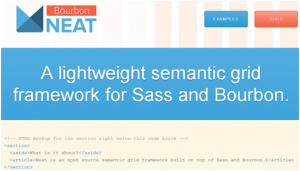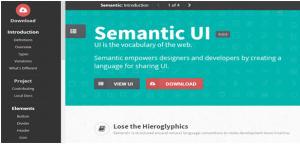Web designers and developers make a creative cult. We constantly strive towards that perfect web design through which we can mark our presence on the World Wide Web. Responsive web design is the future of web design and is pegged to see many new innovations and creative inputs this year. This designing element has witnessed widespread acceptance by individuals and organizations for their personal blogs and business websites in the same tone.
CSS based Responsive Web Design Frameworks
Responsive web design is not something that can be implemented at one go. However, web designers and developers can use some immensely useful CSS-based frameworks for turning a normal website into a responsive one. These tools require minimal JavaScript and CSS programming. Through this article, I will cover some of the best responsive design frameworks available in the market.
Neat
Neat is a semantic grid CSS based responsive design framework built on top of Sass and Bourbon. The developers have kept everything simple and easier to implement as compared with other similar tools available in the market. Neat is lightweight and can handle most grids used in modern web design.
Source- neat.bourbon.io
Sematic UI
Semantic UI provides a great foundation and flexibility for responsive web development. This CSS web design tool offers separate UI collection, UI elements and UI modules that can be integrated with a website’s source code, besides providing real-time JavaScript behavior and bug output.
Source – semantic-ui.com
Ingrid
Just like Neat, Ingrid is a lightweight responsive CSS layout tool, and working with it seems kind of fun. It is highly customizable and the best part about Ingrid is its ability to reduce classes on individual units. The learning curve might be a little steep, but this framework delivers some great results. I advise all web designer folks to give this tool a try.
Source- piira.se/projects/ingrid
Bootstrap
Developed by Twitter, Bootstrap is probably the most popular responsive web design tool at the moment. This CSS framework has been equipped with numerous features and modules, which has made it immensely popular among the web design and development community.
Source – getbootstrap.com/2.3.2
Foundation
All the great things are kept for the end and likewise, I kept Foundation for the last. This CSS based responsive design framework, developed by ZURB, is perhaps the most used tool for creating highly innovative and clutter free responsive website. Apart from the responsive feature, one can also create mobile websites using Foundation. It happens to be a personal favorite of mine as well.
Source – foundation.zurb.com
Conclusion
Responsive website have evolved from being the next big thing in web design. Hence, web designers need to involve and create more responsive elements in their work in order to stay competitive in the market. The CSS based web design tools mentioned in this article provide a basic approach towards developing responsive websites, and it is the application part where we need to indulge and innovate.





